Today we are taking a look at the Intel Xeon E3-1230 V2, which is a new Ivy Bridge Xeon E3 series CPU built on Intel’s new 22nm process. Last year, ServeTheHome was the first site to review the Intel Xeon E3-1230 (V1) that was long delayed as there was a delay with the Sandy Bridge Bromolow platform. This year, we will be reviewing the vast majority of Intel’s Xeon E3 lineup once more starting with the Xeon E3-1230 V2. For those wondering why we decided to review the Intel Xeon E3-1230 V2 first, the reasons are simple, it was the most viewed Xeon E3 review of the Sandy Bridge generation and extremely popular as it was the lowest cost 4 core 8 thread Xeon CPU available in the previous generation. Intel has upgraded this generation with a few new features, a power sipping 22nm tri-gate manufacturing process, PCIe 3.0, 1600MHz DDR3 unbuffered ECC memory support and a 100MHz speed bump over the Sandy Bridge generation. For those wondering, here is the Intel ARK comparison of the Sandy Bridge v. Ivy Bridge generations. Let’s take a closer look!
Test Configuration
Supermicro upgraded its X9SCx series to support the Ivy Bridge Xeon E3 family so I decided to use one of the most popular Xeon E3 LGA 1155 motherboards, the Supermicro X9SCM-F for the Ivy Bridge Xeon E3 reviews.
- CPU: Intel Xeon E3-1230 V2
- Motherboard: Supermicro X9SCM-F
- Memory: 16GB Kingston ECC 1600 CL11 DDR3 4x 4GB UDIMMs
- OS Drive: OCZ Vertex 4 256GB
- Enclosure: Norco RPC-4224
- Power Supply: Corsair AX750 750w 80Plus Gold PSU and PicoPSU 150XT with 150w power brick for power consumption testing.
- OS: Windows 7 Professional SP1 64-bit
As one may recall, the Intel C204 chipset does not allow one to use the integrated graphics of the Intel E3-12×5 (V1/V2) series CPUs so it is best to pair the X9SCM-F with a Xeon E3-12×0 series CPU. The older C206 or newer C216 chipsets are better pairings for the E3-12×5 series CPUs with onboard GPUs.
Performance Tests
I will start off this section by saying that the standard test suite was built to test 1-8 thread single CPU systems such as the Sandy Bridge and Ivy Bridge Intel Xeon CPUs. With platforms like this one, I have been slowly altering the mix. Clearly, one would expect a different workload between the Xeon E5-2687W CPU and something found in a low-end, low-power server like a Pentium G630. Moving to the 16-64 core realm where the Xeon E5 series will play, that is becoming the norm today, I think that it will become ever more important to develop a second test suite.
Cinebench R11.5
I have been using Cinebench benchmarks for years but have held off using them on ServeTheHome.com because the primary focus of the site until the past few months has been predominantly storage servers. With the expansion of the site’s scope, Cinebench has been added to the test suite because it does represent a valuable benchmark of multi-threaded performance. I have had quite a few readers contact me about this type of performance for things like servers that are Adobe CS6 compute nodes and similar applications. Cinebench R11.5 is something that anyone can run on their Windows machines to get a relative idea of performance and both Ivy Bridge, Sandy Bridge and Sandy Bridge-EP systems run it well.
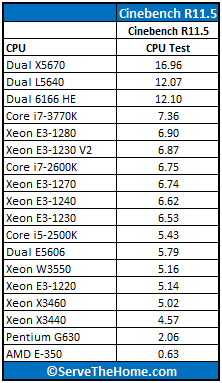
7-Zip Compression Benchmark
7-Zip is an immensely popular compression application with an easy to use benchmark and has been a staple on this site for years. The 1GB benchmark size is used because using a smaller size gives wildly different results and on modern CPUs, small compression tasks take very little time.
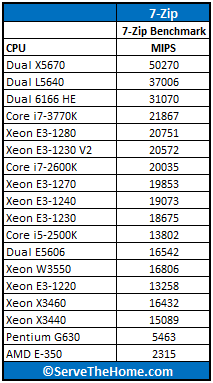
Here we see the pattern continue with the Intel Xeon E3-1230 V2 being slightly bested by the Xeon E3-1280 V1 and ahead of the E3-1270 V1. 7-Zip also shows off nicely the difference between this CPU and the older Lynnfield based Xeons that are putting out around 75% of the low-end Ivy Bridge quad core eight thread Xeon.
TrueCrypt Encryption Benchmarks
With Intel’s focus on its AES-NI features TrueCrypt can look a bit skewed. Unlike some dubious drivers over the years that were optimized for benchmarks over real world application, Intel’s AES-NI feature does encompass the addition of specialized hardware. This specialized hardware has many practical uses and is becoming more supported. For example, users of Solaris 11 can utilize the AES-NI features to see much higher throughput on encrypted volumes. AMD has started offering AES-NI with their Bulldozer CPUs, and I will have those results added to future pieces. Let’s see how Intel does here.
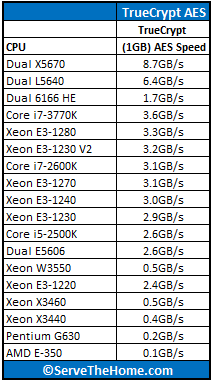
This is pretty much as we would expect from the new CPUs. As we can see here, the Xeon E3-1230 V2 again is crowding the Xeon E3-1270 V1 and Xeon E3-1280 V1 so there is certainly an architectural advantage for Ivy Bridge over Sandy Bridge.
Handbrake 0.9.5 x264 Encoding Benchmarks
I am still using Handbrake v0.9.5 simply because the Handbrake team does do some nice tweaking between annual versions and all of the other CPUs have been tested with v0.9.5. We will begin to collect data on v0.9.6 and start using that once we have critical mass. Either way, Handbrake is an extremely popular x264 encoding and transcoding application as it is very common practice these days to encode video for various tablets, phones and other devices. These transcodes also take a fair amount of time so having faster CPUs is important.
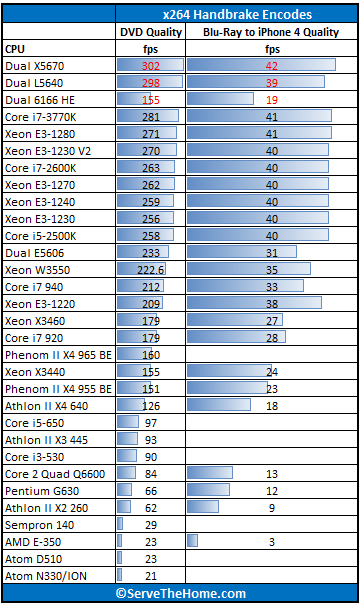
I am purposefully keeping many results in here. This shows first that the Intel Xeon E3-1230 V2 performs very similarly to the Xeon E3-1230 V1 in some instances. Second, it gives a good idea on what the differences are between a few generations of CPUs. As nice as the Intel Atom chips are, they still put out less than 1/10th the performance of a ~$215 CPU.
Power Consumption
Intel’s move to 22nm is something hearlded as a new era in lower power consumption, especially with tri-gate technology and future process improvements that will increase that number. Using an Extech 380803 True RMS power analyzer which is a really nice unit that even records usage over time.

Here we see something very interesting, in that we are only seeing 3w less at idle and 13w max power consumption difference between the Sandy Bridge Xeon E3-1230 and the Ivy Bridge Xeon E3-1230 V2. The min to max power delta has decreased by 10w over the previous generation part also. This is about what one would expect. It should be noted that those expecting much lower power consumption figures are going to be disappointed. One of the big drivers here is the fact that most IPMI 2.0 implementations with dedicated NICs take in the 15-20w range just to run. Given that context, the new Ivy Bridge Xeon E3 series really does well here.
Conclusion
Overall, this is one of those generational upgrades that is going to completely replace the previous generation in the market. Both CPUs use the same sockets, and motherboards such as the Supermicro X9SCM-F can utilize a simple BIOS upgrade to enable the DDR3 1600 speeds and the PCIe 3.0 capabilities of the Ivy Bridge chips. With that being said, and I will reiterate this on subsequent Ivy Bridge Xeon E3 reviews, unless one genuinely needs slightly lower power consumption to hit a certain power output for a data center, or PCIe 3.0, I think there is very little reason to replace the Sandy Bridge based Intel Xeon E3 series CPUs with the newer Ivy Bridge V2 parts. One thing I also think will be interesting is when Intel finally enables vPro KVM-over-IP to be a competitor to current IPMI 2.0/ iKVM schemes. The new Ivy Bridge Xeon E3-1200 series CPUs have a much more capable GPU than what is commonly found onboard motherboards and it is too bad Intel has not put forth a better effort on that front so it could consolidate on the ‘5’ series CPUs with on-die graphics. Overall though, I think those still running 45nm LGA 1366 parts are going to have to start looking at the Ivy Bridge Xeon as a viable alternative at this point. There is a serious performance benefit to the new UP Xeon family and an equally important reduction in power consumption.
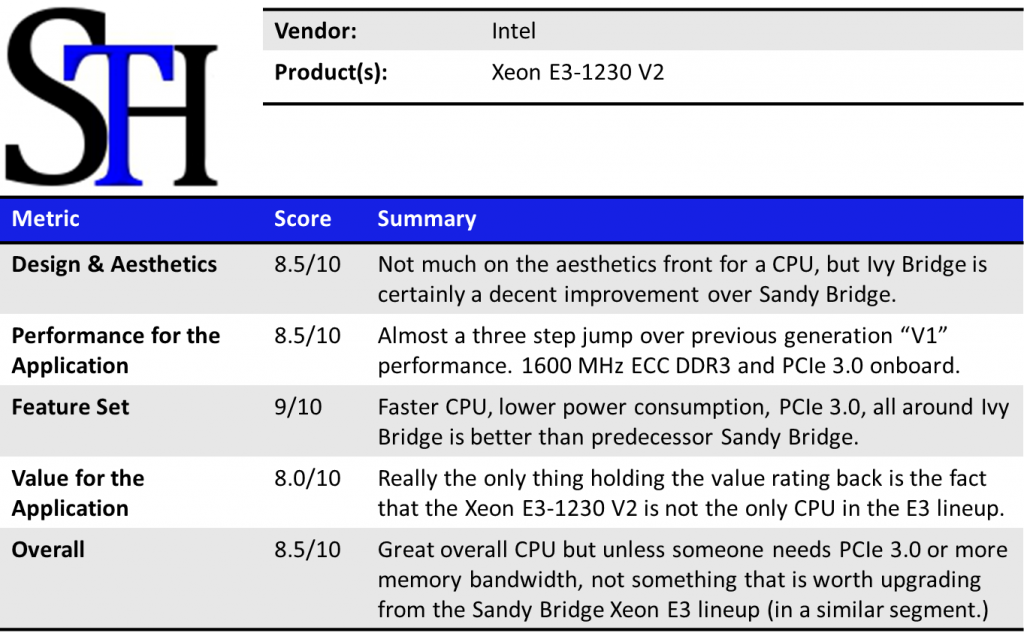




Always the first and best Patrick. Appreciate not having to read 20 pages and you being first with this.
good job dude! first review i have seen
I see test configuration uses different powersupply than E3-1230 V1 article. In my opinion this renders power consumption results a lot less comparable. Specially because this article is tested with higher power rated supply and those have worse efficiency in lower loads in general.
Also this V2 test setup uses 2 memory modules more ram, which should lead to ~4W more power consumed? And V1 articles used Tyan’s motherboard.
Would it be possible do comparison between V1 and V2 models running in same clock using same test setup?
Jyrki: Compare to the E3-1240 V1 for clock-to-clock. I tried the Xeon E3-1230 V1 out on the X9SCM-F and saw the test platform very similar numbers to that Tyan setup (+/- 1w). The Tyan board I could not get to run all tests successfully. It actually took me quite a long time of swapping hardware to get everything to be relatively even but had to do at minimum a component change for the faster memory. It turned out that using four sticks of DDR3 was one of the keys to get me to +/- 1w tolerance between the platforms. This was something I spent a lot of time mocking-up on the V1 system before the V2 launch.
Good catch on the PSU. I forgot to add the PicoPSU 150XT which I use for power consumption on <135w total power consumption systems. Will add that.
Makes sense. Numbers seem inline with expectations.
The Intel ARK comparison,in the Expansion Options section, indicates that the V2 only has 1 PCI Express Port, while the V1 has 2. How does this impact the number of PCI lanes on the motherboard, and potentially, the existing motherboards that are supposed to be able to support this chip?
The non Xeon desktop Ivy Bridge cpus are running very hot, according to several reviews. They are typically 15 degrees celsius warmer than Sandybridge cpus.
How about the IvyBridge Xeon versions, are they warmer than the Sandybridge Xeon versions too?
An idea when these CPUs will be available in the UK? I’ve tried my usual suspects (overclockers.co.uk, scan.co.uk) and there’s no sign of it. Any idea on price?
Ed, NewEgg pricing in the US is about $10 more than the V1 versions. Not sure why they are so slow to get out in the UK, but distributors started shipping a while back. Guessing channels are asking to clear V1 parts before pushing V2.
Thanks for sharing info…
When intel is planning to launch C216 Chipset based motherboard?
The C216 is launched. It is more of a question of vendors supporting it and releasing boards for it. Intel didn’t do a huge C2xx platform upgrade with Ivy Bridge like they did with Sandy Bridge (C20x v. X3400)
Thanks Patric!!!
You mean intel will not launch soon Server Motherboards based on C216…I dont know what is wrong with Intel these days…these days they are not first one to launch Motherboards!!!!
I am stuck i cannot build lab…
I dont know what is use of buying Ivy Bridge processor if Ivy Bridge Motherboard is not launched by Intel…
AMD is better in this regards…
Pravin – The Ivy Bridge and Sandy Bridge platforms were fairly similar. Most vendors did not update to C216 because they could get PCIe 3.0 with just a BIOS update on the C206 boards.
Hello Patrick :-) Thank You for reply.
is PCIe 3.0 & USB 3 is only difference between Ivy & Sandy Bridge?
I dont know which feature i will miss if i build build system using C20X!!!
Thank You :-)
Hello Patrick Kennedy,
is PCIe 3.0 & USB 3 is only difference between Ivy & Sandy Bridge?
I dont know which feature i will miss if i build build system using C20X!!!
Thanks,
Pravin
a lot of information ! i want to setup a server but don;t know how choose cpu is right
Hi Patrick, can u give me some advices which MOBO I shd get with Xeon E3 1230v2?
Does gb-z77x-d3h support it?
Dolp this is common topic on the forums. Get a server mobo.
Stick with the i7/i5 unlocked (k) processor if your going with the desktop board, and looking for raw power. I have this processor with server board and it only runs 3.5GHz (even though it says turbo 3.7Ghz). My i7 2600K can run 4.2GHz 24/7 even on the stock cooler. Now running 4.8Ghz with antec Kuhler 920 24/7 Folding@home.